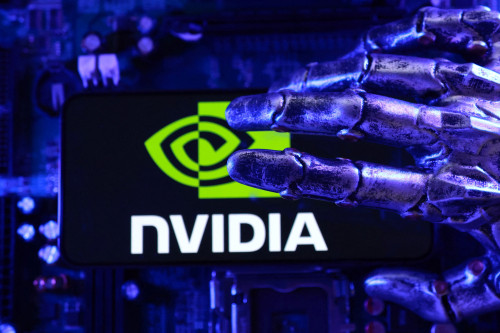By Suzanne McGee
(Reuters) -AI hype that has helped push U.S. stocks to fresh records this year has driven an explosion in leveraged single stock exchange-traded funds, a universe of speculative products that is likely to be tested by Nvidia’s Wednesday earnings.
Companies that investors expect to benefit either directly or indirectly from the AI revolution now dominate U.S. single stock leveraged and inverse ETFs, underscoring investor demand for products that magnify their AI-themed bets, according to a Reuters analysis of industry data from issuers, Morningstar and CFRA Research.
So far in 2025, asset managers have launched 112 U.S.-listed leveraged and inverse ETFs tied to a single stock, compared with 38 in all of 2024, according to data from Morningstar, CFRA Research and issuers, leading some analysts to warn the market is getting overcrowded.
Leveraged and inverse ETFs, which allow investors to profit when shares rise or fall, use swaps or options to produce those targeted returns and are attractive to speculators eager to play daily price moves.
All told, more than half of the total 190 single stock leveraged and inverse ETFs listed in the U.S. now riff off the AI theme, accounting for $17.7 billion of the $23.7 billion invested in the inverse and leveraged ETF universe, the Reuters analysis found.
Those ETFs provide exposure to companies like AI-focused chipmakers like Nvidia, as well as hot AI plays like electric carmaker Tesla, whose futuristic robo-taxis rely on AI, data analytics software company Palantir, as well as energy companies powering AI data centers, like NuScale Power .
One of the largest, the GraniteShares 2x Long NVDA Daily ETF, has accumulated $4.56 billion in assets since its launch in December 2022.
Some of the biggest swings in share prices and, in turn, leveraged stock ETFs, occur when a company announces earnings, said Bryan Armour, ETF analyst at Morningstar. Options traders are pricing in about a $260 billion swing in Nvidia’s market value following its results, Reuters reported on Monday.
“There are more and more opportunities every day for investors to gamble on individual stocks that are part of this dominant AI theme, and any earnings announcement is going to be key,” Armour said.
That effect was highlighted on Tuesday, when shares in AI-driven database company MongoDB skyrocketed more than 23% in after-hours trading, after it reported better-than-expected second quarter earnings and announced big gains in AI-related clients.
That triggered a 46% gain in the Tradr 2x Long MDB Daily ETF launched by Tradr ETFs only two weeks earlier.
Matt Markiewicz, head of product and capital markets at Tradr ETFs, said the company is looking for new ways to explore the AI theme, pointing to a 2x ETF tied to Constellation Energy it launched in July. He expects that the demand for power generation to support data centers will surge alongside AI adoption.
“There is such a thirst for companies benefiting from the AI buzz,” he said.
RISKY PRODUCTS?
But price swings in the underlying stocks magnify these ETFs’ volatility, and critics caution that retail investors who are the predominant users may not fully grasp how the ETFs will react.
In late January, Nvidia shares plunged 17% on reports that Chinese AI lab DeepSeek released a large language model investors thought might chip away at Nvidia’s dominance. The GraniteShares 2x ETF fell nearly 34%.
“We’re providing what people want; if people want AI exposure, that’s where we’re going to focus resources,” said Will Rhind, founder of GraniteShares.
There are now just as many ETFs offering leveraged exposure to Nvidia as there are ETFs tied to the entire $52 trillion Standard & Poor’s 500 index.
“If you factor in the risk surrounding AI right now after all of its gains, and add the risk of leverage on top of that, well, there’s more potential for losses,” said Dave Nadig, president and director of research at ETF.com.
While performance can vary depending on how the issuer obtains the leverage, or on the holding period, many of these ETFs have delivered results that hew closely to their target returns of 1.5x or 2x, industry executives point out.
“The underlying stock is going to do what it’s going to do, our job is to make sure ETF does what it says it will do,” said Tradr’s Markiewicz.
For issuers, the products are attractive because they generally command fees averaging 0.96% compared to 0.54% for the ETF industry as a whole. But Nadig warned the market is overcrowded, adding there will likely be a “shakeout.”
(Reporting by Suzanne McGee; editing by Michelle Price and Nick Zieminski)

